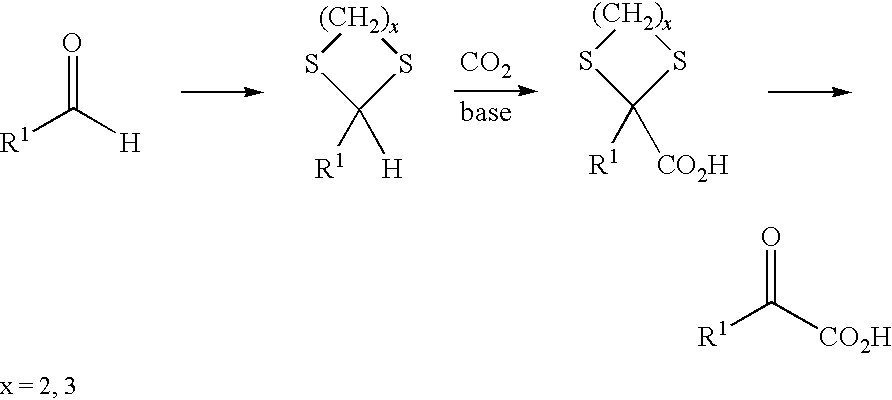PROCESS FOR PREPARING a-KETO ACIDS AND DERIVATIVES THEREOF
a technology of which is applied in the field of preparing a-keto acids and derivatives thereof, can solve the problems of high stability, serious disadvantages, and inability to recycle and reuse dithiols, and achieve the effect of high cost of suitable dithiols and high stability
- Summary
- Abstract
- Description
- Claims
- Application Information
AI Technical Summary
Benefits of technology
Problems solved by technology
Method used
Image
Examples
example 1
[0071]Preparation of 1,1,3-tris(methylthio)propane (2) from 3-(methylthio)propanal (1)
[0072]3-(methylthio)propanal (1) (1.44 mol, 150 g) was saturated at 0° C. with HCl (g) and then added dropwise directly to MeSH (6.25 mol, 300 g) at 0° C. over a period of 30 minutes. The reaction mixture was heated to 20° C. and stirred at 20° C. for 24 h. After the excess MeSH had been removed under reduced pressure, GC analysis showed the following product distribution: 91% thioacetal (2) and 8% 3-(methylthio)propanal (1). For further purification, this mixture was dissolved in diethyl ether and washed with a 30% aqueous sodium pyrosulfite (Na2SO2O5) solution. After phase separation, the organic phase was dried over MgSO4. After the solvent had been removed, the thioacetal (2) was obtained as a pale-yellow colored oil (168 g, yield=64%, GC purity=98%).
[0073]1H NMR of 1,1,3-tris(methylthio)propane (2) (500 MHz, CDCl3): δ=2.01-2.05 (m, 2H, CH2), 2.11 (s, 9H, 3×SCH3), 2.71 (t, 3J=7.3 Hz, 2H, CH2), ...
example 2
[0075]Preparation of 1,1,3-tris(methylthio)propane (2) from acrolein (3)
[0076]Acrolein (3) (89 mmol, 5.0 g) was added dropwise at −78° C. with stirring to MeSH (358 mmol, 17.2 g), which had been saturated with HCl gas at 0° C., over a period of 15 minutes. This mixture was heated slowly to 20° C. and then stirred further at 20° C. for 24 h. After removal of the excess MeSH under reduced pressure, this mixture was dissolved in diethyl ether and washed with a 30% aqueous sodium pyrosulfite solution. After phase separation, the organic phase was dried over MgSO4. After distillation (88° C. at 1.2 mbar), the pure thioacetal (2) was obtained as a pale-yellow colored oil (11.4 g, yield=70%, GC purity=98%). The NMR characterization gave the same data as in Example 1.
example 3
[0077]Preparation of 2,2,4-tris(methylthio)butanoic acid (4) by umpolung reaction of 1,1,3-tris(methylthio)propane (2) with dry ice (CO2)
[0078]In a three-neck flask under a protective gas atmosphere, 1,1,3-tris(methylthio)propane (2) (3.65 g, 20 mmol) was dissolved in 50 ml of abs. THF. Subsequently, at −20° C., a butyllithium solution in n-hexane (14 ml, 1.6 M) was slowly added dropwise with stirring. In the course of this, the solution turned bright yellow. After stirring had been continued at this temperature for a further 2 h, anhydrous dry ice (CO2, 10 g) which had been washed beforehand in abs. THF was added in portions at −70° C. The reaction solution was thawed slowly to 20° C. and a 10% aqueous KOH solution (80 ml) was added. After phase separation, the organic phase was washed with 10% aqueous KOH solution (2×50 ml). The combined KOH phases were washed with diethyl ether (3×30 ml) and then adjusted cautiously to pH 1 with conc. HCl while cooling. The product was extracted...
PUM
| Property | Measurement | Unit |
|---|---|---|
| temperature | aaaaa | aaaaa |
| temperature | aaaaa | aaaaa |
| temperature | aaaaa | aaaaa |
Abstract
Description
Claims
Application Information
 Login to View More
Login to View More - R&D
- Intellectual Property
- Life Sciences
- Materials
- Tech Scout
- Unparalleled Data Quality
- Higher Quality Content
- 60% Fewer Hallucinations
Browse by: Latest US Patents, China's latest patents, Technical Efficacy Thesaurus, Application Domain, Technology Topic, Popular Technical Reports.
© 2025 PatSnap. All rights reserved.Legal|Privacy policy|Modern Slavery Act Transparency Statement|Sitemap|About US| Contact US: help@patsnap.com



